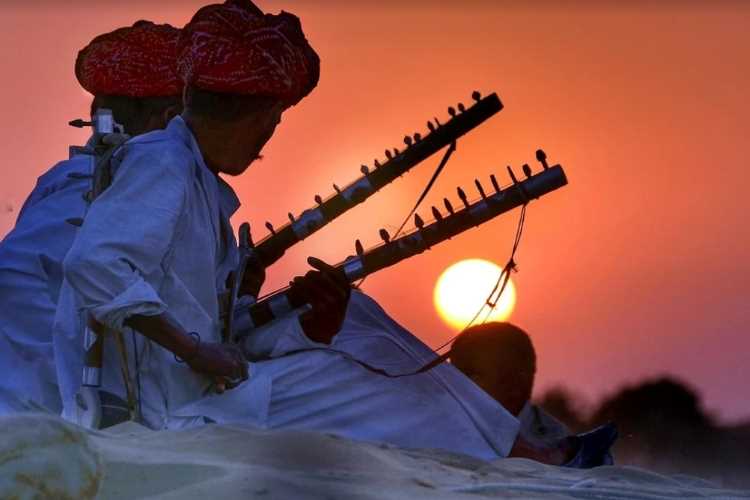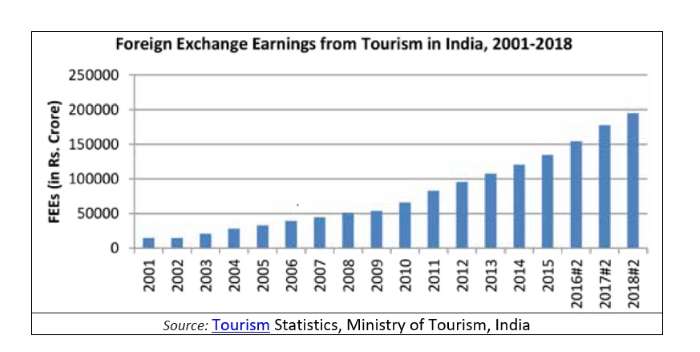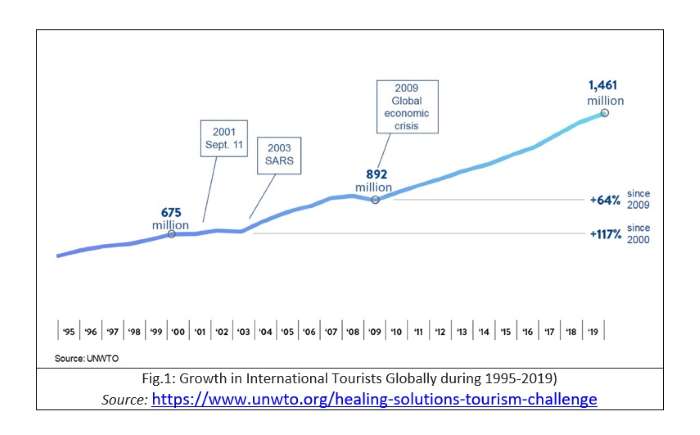
By Sutheeshna Babu S
The world remains virtually shut as it struggles to contain the new coronavirus that is causing unprecedented destruction. As this article is being published, the death toll has mounted to 1.54 lakhs, while there are more than 2.24 million confirmed Covid-19 cases globally. The International Monetary Fund expects the pandemic to peak in the April-June period in most parts of the world. International borders of more than 100 countries remain closed for more than a month. IMF has predicted a deep recession in 2020 due to the pandemic and the steps taken to contain it. Of the major economies, only India and China are expected to grow, albeit at a slow rate.
The mood of the world is gloomy and the anxiety could prolong for months. In such situations, the focus should be on the survival of human-beings. Still, it is extremely important to reflect on the economic crisis and ponder over ways to restart economic activity.
Tourism matters
The biggest victim of the Covid-19 pandemic has been the travel and tourism industry that contributes 10.3% of global GDP. The industry provides 330 million jobs, that is 10% of all jobs in 2019. The sector experienced 3.5% growth last year, outpacing the global economic growth (2.5%) for nine consecutive years. India witnessed phenomenal growth in all key indicators — domestic and foreign tourist arrivals, outbound travel, foreign exchange earnings, employment generation and total tourism receipts. The foreign tourist arrivals increased nearly four-fold from 2.54 million in 2001 to 10.56 million in 2018. Correspondingly, foreign exchange earnings grew from $3.2 billion to $28.6 billion, a nine-fold increase, during the period.

The growth in domestic tourism has been more impressive. Domestic tourism remained robust all these years, expanding from 236.47 million tourists in 2001 to 1855 million in 2018, an increase of 7.8 times. The SARS outbreak in 2002-03 and the global recession in 2009 affected foreign tourist arrivals, but increase in the number of domestic tourists more than made up for this shortfall. In many ways, domestic tourism segment forms the backbone of Indian tourism industry and constitutes nearly three fourths of the total tourism revenues.
As an industry, tourism is central to India’s development schemes. Besides being a prime source of foreign exchange earnings, the sector accounts for 5.2% of the country’s GDP and 12.38% of the total employment. Such robust numbers underpin the importance of the sector to the Indian economy.
READ: Make PDS more inclusive, give ration cards pan-India validity
2020 challenges for tourism
The challenge posed by the Covid-19 epidemic is unparalleled in many ways. Tourism as an industry is built around mobility and the enabling mechanisms of consumption that are mostly intangible. It is natural that the industry faces a collapse in the face of a pandemic. If the Covid-19 predictions made by international agencies are anything to go by, resumption of mobility to reasonable level will not happen before October 2020. The tourism industry is completely shut down from mid-March. Prolonged shutdown could affect the employment and income prospects of the sector to a great extent, given that MSMEs constitute roughly 85% of all tourism establishments.
The tourism industry accounts for a tenth of global GDP and jobs. According to the estimates of the World Travel and Tourism Council, the corona virus outbreak will result in the loss of 50 million jobs in the travel and tourism industry. Asia will account for 30 million of the lost jobs. Once the outbreak is contained, it will take another 10 months for the tourism industry to recover fully, according to a news report published by the World Economic Forum. Even though it would be difficult to assess of the extent of employment losses in India, it should be huge given the MSME character of the sector.
Further, tourism industry feeds huge masses of the poor and weaker sections, less literate and low-skilled. Over 95% of the Indian hospitality industry is dominated by bed & breakfast facilities, guest houses and other small-scale units. It would be safe to assume that at least three-fourths of tourism sector are in the informal sector. The impact of a crisis of this magnitude could crush the industry.
The mobility-driven tourism industry should also worry about the geographies affected by the new corona virus, of virus spread and its scaling trajectory. The pandemic has ravaged all major tourism corridors of the world, affecting both tourist generating and receiving regions across Western Europe, the US, West Asia, South Asia, China, East Asia, southeast Asia and Australia. The countries in these regions nurture robust domestic tourism markets, which is very significant for countries such as India and China. Globally, 71.2% of the spending comes from domestic tourists.
READ: Great lockdown: Online classes, remote working widen India’s digital divide

The WTO had projected 3-4% growth for tourism in 2020. But the figures were revised after the Covid-19 pandemic broke out. International tourist arrivals could see a negative growth of 1-3%. As it stands, resumption of tourism activities from the rock bottom is still beyond informed guesswork. The uncertainties could impact the prospects of tourism and travel industry as well as its contribution to the economy and employment generation.
As per IMF estimates, there will be a 2 percentage point loss in annual GDP for each month of lockdown. The tourism sector alone would face a 70% decrease in output. This must be viewed in the backdrop of a robust employment scenario post-2009 recession. For instance, the accommodation and food services sector alone saw a growth of around 35% during 2010-18, while all sectors have recorded a growth of 11%. Further, occasional hiccups in the first decade of 21stcentury notwithstanding, tourism grew in strength and maintained a consistent growth trajectory, particularly after 2010.
In India, tourism has already fallen to abysmal levels. Going by the initial estimates of Centre for Asia Pacific Aviation (CAPA India), the domestic traffic could fall by almost half from 140 million in FY2020 to around 80-90 million in FY2021. Correspondingly, a huge slump in international traffic is also feared from approximately 70 million to 35-40 million. As a consequence, 200-250 aircraft could remain surplus in next 6-12 months in India.
READ: Coronavirus impact: Indian economy may prove doomsayers wrong
Across the hotel sectors, occupancy was not affected till the end of February. In March, there was a 45% fall from the previous year in major cities. Much of the decline is due to the nation-wide shutdown announced by Prime Minister Narendra Modi on March 25. HVS Research estimates a 16.7– 20.5% decline of overall occupancy from 2019 for branded hotels. It could then lead to a 31-36.2% fall in RevPAR, or revenue per available room. Projected loss of overall revenue in the sector could be in the range of $8.85 billion to $10 billion, a drop of 39-45% from previous year.
Industry bodies such as IATO are worried about the all-round squeeze in all tourist segments. KPMG projects a potential job loss of 38 million, or around 70% of the total workforce. Recovery of the sector is crucial to the rebound of the Indian economy. The government should consider several demands made by the tourism industry with all seriousness. Some of these demands are removal of taxes / compliances charges on air travel, rationalisation/ cut in VAT on ATF across the country and a moratorium on all bank payments.
Tourism industry is extremely crucial for India, given its share in national GDP and employment generation. Boosting tourist arrivals – both domestic and foreign – through focused fiscal and monetary incentives is crucial for both central and state governments in this hour of crisis. The policies must come in a bundle, piloted separately as steps to support the survival and revival of this crucial industry.
(Prof Sutheeshna Babu is a renowned expert in tourism economy. He is nodal officer, National Institute of Watersports, Goa. Views are personal and not of the organisation.)

